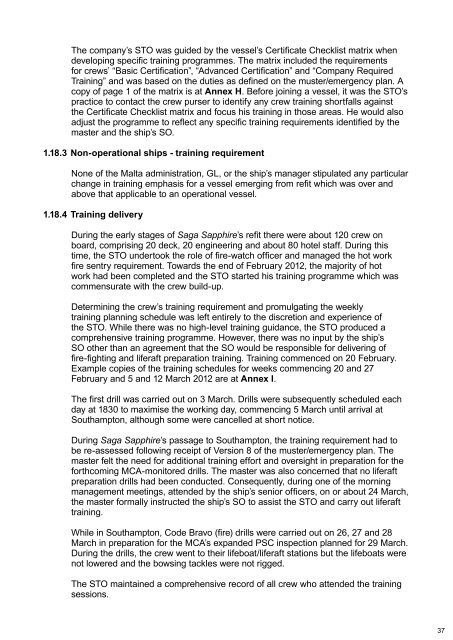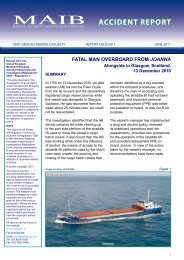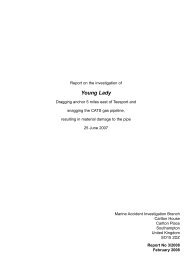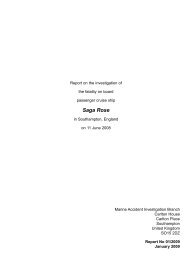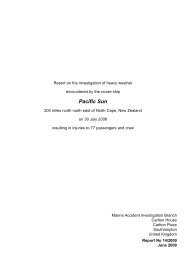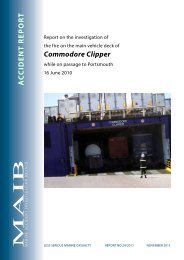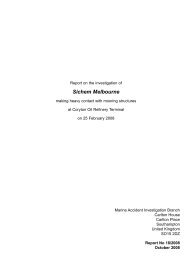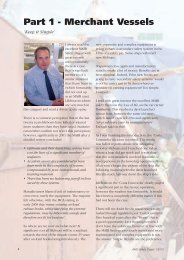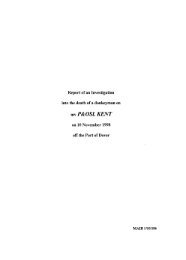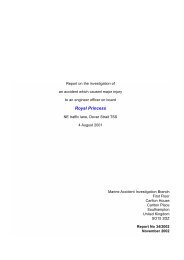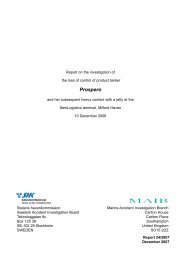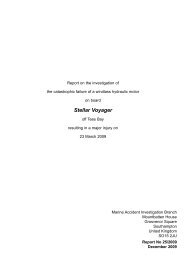SECTION 4 - Marine Accident Investigation Branch
SECTION 4 - Marine Accident Investigation Branch
SECTION 4 - Marine Accident Investigation Branch
You also want an ePaper? Increase the reach of your titles
YUMPU automatically turns print PDFs into web optimized ePapers that Google loves.
The company’s STO was guided by the vessel’s Certificate Checklist matrix when<br />
developing specific training programmes. The matrix included the requirements<br />
for crews’ “Basic Certification”, “Advanced Certification” and “Company Required<br />
Training” and was based on the duties as defined on the muster/emergency plan. A<br />
copy of page 1 of the matrix is at Annex H. Before joining a vessel, it was the STO’s<br />
practice to contact the crew purser to identify any crew training shortfalls against<br />
the Certificate Checklist matrix and focus his training in those areas. He would also<br />
adjust the programme to reflect any specific training requirements identified by the<br />
master and the ship’s SO.<br />
1.18.3 Non-operational ships - training requirement<br />
None of the Malta administration, GL, or the ship’s manager stipulated any particular<br />
change in training emphasis for a vessel emerging from refit which was over and<br />
above that applicable to an operational vessel.<br />
1.18.4 Training delivery<br />
During the early stages of Saga Sapphire’s refit there were about 120 crew on<br />
board, comprising 20 deck, 20 engineering and about 80 hotel staff. During this<br />
time, the STO undertook the role of fire-watch officer and managed the hot work<br />
fire sentry requirement. Towards the end of February 2012, the majority of hot<br />
work had been completed and the STO started his training programme which was<br />
commensurate with the crew build-up.<br />
Determining the crew’s training requirement and promulgating the weekly<br />
training planning schedule was left entirely to the discretion and experience of<br />
the STO. While there was no high-level training guidance, the STO produced a<br />
comprehensive training programme. However, there was no input by the ship’s<br />
SO other than an agreement that the SO would be responsible for delivering of<br />
fire-fighting and liferaft preparation training. Training commenced on 20 February.<br />
Example copies of the training schedules for weeks commencing 20 and 27<br />
February and 5 and 12 March 2012 are at Annex I.<br />
The first drill was carried out on 3 March. Drills were subsequently scheduled each<br />
day at 1830 to maximise the working day, commencing 5 March until arrival at<br />
Southampton, although some were cancelled at short notice.<br />
During Saga Sapphire’s passage to Southampton, the training requirement had to<br />
be re-assessed following receipt of Version 8 of the muster/emergency plan. The<br />
master felt the need for additional training effort and oversight in preparation for the<br />
forthcoming MCA-monitored drills. The master was also concerned that no liferaft<br />
preparation drills had been conducted. Consequently, during one of the morning<br />
management meetings, attended by the ship’s senior officers, on or about 24 March,<br />
the master formally instructed the ship’s SO to assist the STO and carry out liferaft<br />
training.<br />
While in Southampton, Code Bravo (fire) drills were carried out on 26, 27 and 28<br />
March in preparation for the MCA’s expanded PSC inspection planned for 29 March.<br />
During the drills, the crew went to their lifeboat/liferaft stations but the lifeboats were<br />
not lowered and the bowsing tackles were not rigged.<br />
The STO maintained a comprehensive record of all crew who attended the training<br />
sessions.<br />
37


